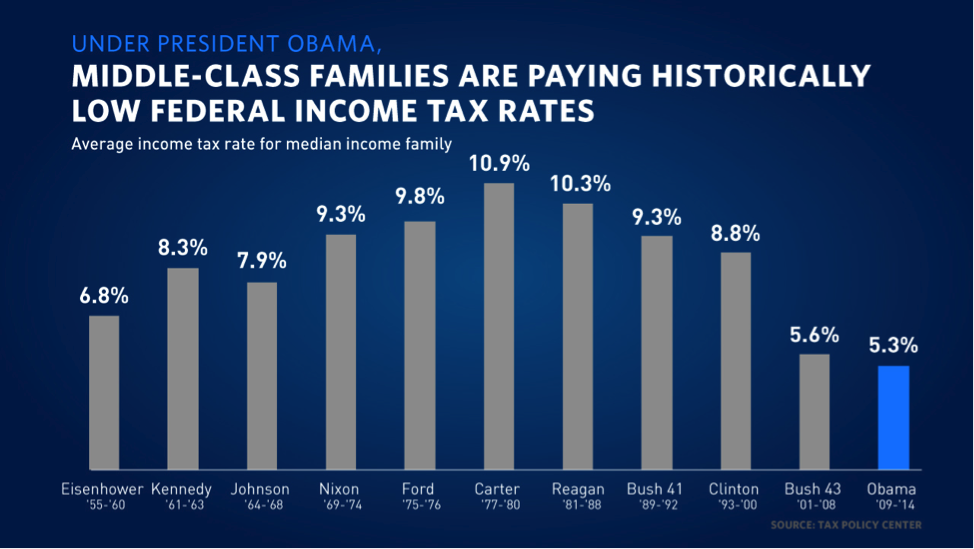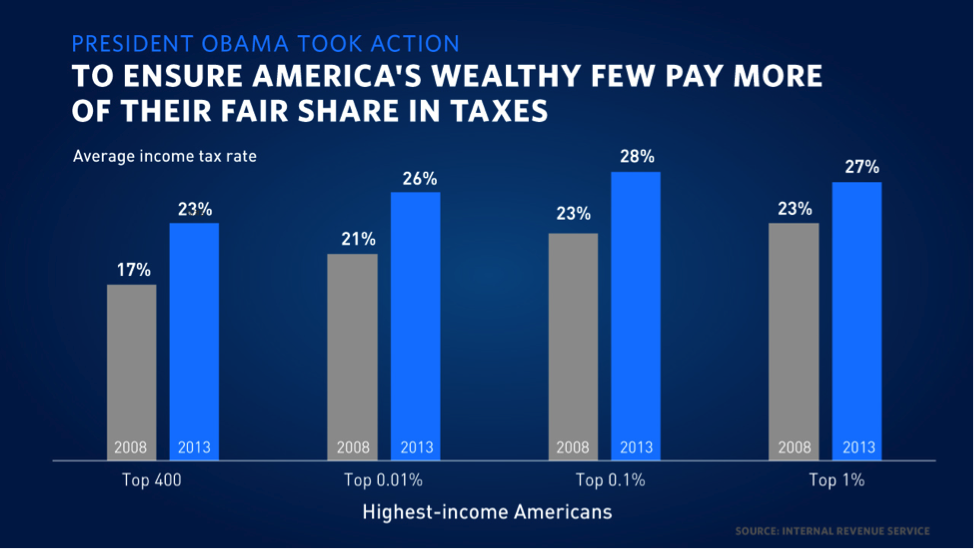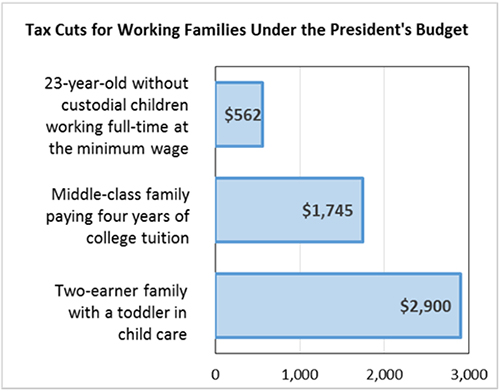Taxes
President Obama has fought to achieve a simpler and fairer tax code that ends tax breaks and tax loopholes for wealthy Americans while helping paychecks go further for middle-class and working families.
We have to set priorities. If we want a strong middle class, then our tax code must reflect our values.President Obama
President Obama has passed wide-ranging tax relief for working families and small businesses — the drivers of economic growth — while also ending tax cuts for the top 2 percent highest-income Americans. But despite this progress, the tax code is still too complicated and full of inefficient loopholes and tax breaks that mostly benefit the wealthy. The President has proposed to simplify our tax code, make it fairer by eliminating large, unfair tax loopholes, and reinvest the savings in measures that will grow the economy and expand opportunity. The President's plan would make paychecks go further in covering the costs of child care, college, and a secure retirement, and would create and improve tax credits that support and reward work.
Tax Cuts for the Middle Class
Under President Obama’s leadership, we have made substantial progress in making the tax code fairer for working families. Under President Obama:
- A typical family making $50,000 a year received tax cuts totaling $3,600 in President Obama’s first term — more if they were putting a child through college.
- Improvements to the Earned Income Tax Credit (EITC) and Child Tax Credit (CTC), enacted in 2009 under President Obama and recently made permanent, provide roughly 16 million working families a year with a tax cut of about $900 on average to help make ends meet. Learn more about the bipartisan agreement making these important expansions permanent.
- The American Opportunity Tax Credit (AOTC), first enacted under President Obama in 2009 and recently made permanent, provides families and students paying for college with up to $10,000 of tuition tax credits over four years.
- Bipartisan legislation permanently kept income tax rates low for 98 percent of Americans, while asking the wealthiest households to pay more to help reduce the deficit, including by restoring top tax rates to their levels under President Clinton, and restoring limits on deductions for high-income taxpayers. Learn more about the American Taxpayer Relief Act of 2012.
As a result, middle-class taxes are at historically low levels, with the typical middle-income family paying lower federal income taxes than in almost any other period in the last 60 years. Relative to the tax code in place before the Administration, in 2016 the after-tax income of families in the lowest fifth of the income distribution has increased by more than 6 percent on average — a more than $850 boost — due to the policies enacted since 2009.

At the same time, high-income earners are paying significantly more of their fair share. After the President successfully fought to reverse tax cuts for the highest-income Americans beginning in 2013:
- The highest-income 400 people in the United States – who earned more than $264 million each on average in 2013 – saw their average tax rate rise by more than a third in 2013, from 17 percent to 23 percent, implying they paid about $6.5 billion more in taxes than they would have under the older rules.
- The highest-income 0.1 percent of people in the United States saw their average tax rates increase by more than 6 percentage points in 2013 to 28 percent, implying that they paid more than $50 billion more in taxes than they would have under the older rules.
- Ending wasteful tax breaks for those at the very top has contributed significantly to the progress we have made reducing the budget deficit. Learn more about the Administration’s accomplishments on deficit reduction.

Read more about the progress under President Obama in making the tax code fairer.
Tax Cuts for Small Businesses
President Obama firmly believes that entrepreneurs and small businesses are engines of economic growth, and that their investments and innovation have been at the forefront of our economic recovery. That’s why he and his Administration have focused on strengthening small businesses by signing into law a series of tax cuts for small businesses. Importantly, the President recently signed bipartisan legislation that made permanent several tax cuts for small businesses, including permanently increasing the amount of investments that small businesses can immediately deduct to $500,000 and eliminating capital gains taxes on qualified small business investments. These tax cuts have helped small businesses hire and grow, provide affordable health insurance to employees, and invest in new machinery and equipment. The President also believes we should be doing more to help our small businesses succeed in a changing economy. As part of his Framework for Business Tax Reform, the President has proposed additional tax relief, while greatly simplifying tax filing for small businesses, including:
- Expanded and permanent small business expensing to encourage and reward investment. Small businesses can currently expense up to $500,000 of investment, indexed to inflation, due to recent legislation the President signed. The President would permanently increase the limit to $1 million, indexed for inflation going forward.
- Dramatically simplified accounting for small businesses to reduce taxpayer burden. As part of business tax reform, the President’s plan would let businesses with gross receipts of less than $25 million — 99.6% of all businesses — dispense with most complicated accounting rules, which can be especially complex and costly for small businesses.
- Further simplifications and tax relief, for example by quadrupling the amount of start-up costs entrepreneurs can immediately deduct from their taxes from $5,000 to $20,000 and reforming and expanding the health insurance tax credit for small businesses to help them provide coverage for employees.
A Simpler, Fairer Tax Code That Responsibly Invests in Middle-Class Families
Despite the progress that has been made, middle-class families today still bear too much of the tax burden because of unfair loopholes that are only available to the wealthy and big corporations.
In his 2015 State of the Union Address, the President proposed a plan to simplify our complex tax code for individuals, make it fairer by eliminating some of the biggest loopholes, and use the savings to responsibly pay for the investments we need to help middle-class families get ahead and grow the economy. The President’s plan would help the paychecks of middle-class and working families go further through the following tax cuts and simplifications:
- • An expanded Earned Income Tax Credit for workers without dependent children, which would encourage work and directly reduce the extent and severity of poverty and hardship for more than 13 million workers. Learn more about the President’s proposal to expand the EITC.
- A new $500 second earner credit to help cover the additional costs faced by families in which both spouses work — benefiting 24 million couples a year.
- A simplified and dramatically expanded Child Care Tax Credit that would give a tax cut of up to $3,000 per child for middle-class families with young children. The proposal complements major investments in the President’s Budget to improve child care quality, access, and affordability.
- Simplified, consolidated, and expanded education tax benefits, including an expanded American Opportunity Tax Credit that would provide more students up to $2,500 each year over five years (for a total of $12,500) as they work toward a college degree.
- Retirement savings opportunities for 30 million more workers.The President’s retirement tax reform plan gives 30 million additional workers the opportunity to easily save for retirement through their employer.

The President’s plan is fully paid for by eliminating the biggest tax loophole that lets the wealthiest avoid their fair share of taxes, by making other reforms to capital gains and financial sector taxation, and other reforms. The President’s plan would:
- Close the trust fund loophole — the single largest capital gains tax loophole — to ensure the wealthiest Americans pay their fair share on inherited assets.
- Raise the top capital gains and dividend rate back to the rate that President Reagan signed into law (28 percent).
- Reform financial sector taxation to reduce the incentive for the biggest financial firms to finance their activities with excessive borrowing.
Learn more about the President’s tax plan to help middle-class and working families get ahead.
Investing in America’s Infrastructure and Reforming Our Business Tax System
In addition, the President has put forward a robust framework for fixing the business tax system that is aimed at promoting growth and job creation here in the United States and that ends loopholes that reward companies for moving jobs and profits overseas. The President’s plan would:
- Close dozens of loopholes that harm growth and lower the top corporate tax rate to 28 percent, enhancing U.S. competitiveness and encouraging greater investment in America.
- Bolster incentives for American innovation, clean energy, and manufacturing.
- Modernize the international tax system including establishing a new minimum tax on overseas corporate earnings, to encourage domestic investment, addressing profit shifting, and stopping corporate inversions.
- Simplify and cut taxes for small businesses.
- Restore fiscal responsibility by not adding a dime to the deficit, including paying for business tax cuts Congress has already enacted without offsets. One-time revenues from the transition to the new business tax system would be invested in infrastructure and used to reduce the deficit.